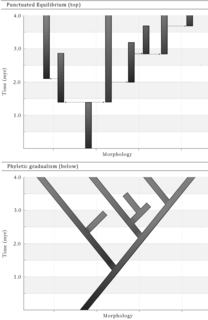Gradualism, from the Latin gradus ("step"), is a hypothesis, a theory or a tenet assuming that change comes about gradually or that variation is gradual in nature and happens over time as opposed to in large steps. Uniformitarianism, incrementalism, and reformism are similar concepts.

Macroevolution in the modern sense is evolution that is guided by selection among interspecific variation, as opposed to selection among intraspecific variation in microevolution. This modern definition differs from the original concept, which referred macroevolution to the evolution of taxa above the species level.

In evolutionary biology, punctuated equilibrium is a theory that proposes that once a species appears in the fossil record, the population will become stable, showing little evolutionary change for most of its geological history. This state of little or no morphological change is called stasis. When significant evolutionary change occurs, the theory proposes that it is generally restricted to rare and geologically rapid events of branching speciation called cladogenesis. Cladogenesis is the process by which a species splits into two distinct species, rather than one species gradually transforming into another.

Stephen Jay Gould was an American paleontologist, evolutionary biologist, and historian of science. He was one of the most influential and widely read authors of popular science of his generation. Gould spent most of his career teaching at Harvard University and working at the American Museum of Natural History in New York. In 1996, Gould was hired as the Vincent Astor Visiting Research Professor of Biology at New York University, where he divided his time teaching there and at Harvard.

Speciation is the evolutionary process by which populations evolve to become distinct species. The biologist Orator F. Cook coined the term in 1906 for cladogenesis, the splitting of lineages, as opposed to anagenesis, phyletic evolution within lineages. Charles Darwin was the first to describe the role of natural selection in speciation in his 1859 book On the Origin of Species. He also identified sexual selection as a likely mechanism, but found it problematic.

Quantum evolution is a component of George Gaylord Simpson's multi-tempoed theory of evolution proposed to explain the rapid emergence of higher taxonomic groups in the fossil record. According to Simpson, evolutionary rates differ from group to group and even among closely related lineages. These different rates of evolutionary change were designated by Simpson as bradytelic, horotelic, and tachytelic.

Foraminifera are single-celled organisms, members of a phylum or class of amoeboid protists characterized by streaming granular ectoplasm for catching food and other uses; and commonly an external shell of diverse forms and materials. Tests of chitin are believed to be the most primitive type. Most foraminifera are marine, the majority of which live on or within the seafloor sediment, while a smaller number float in the water column at various depths, which belong to the suborder Globigerinina. Fewer are known from freshwater or brackish conditions, and some very few (nonaquatic) soil species have been identified through molecular analysis of small subunit ribosomal DNA.

Cladogenesis is an evolutionary splitting of a parent species into two distinct species, forming a clade.

Disruptive selection, also called diversifying selection, describes changes in population genetics in which extreme values for a trait are favored over intermediate values. In this case, the variance of the trait increases and the population is divided into two distinct groups. In this more individuals acquire peripheral character value at both ends of the distribution curve.

A chronospecies is a species derived from a sequential development pattern which involves continual and uniform changes from an extinct ancestral form on an evolutionary scale. This sequence of alterations eventually produces a population which is physically, morphologically, and/or genetically distinct from the original ancestors. Throughout this change, there is only one species in the lineage at any point in time, as opposed to cases where divergent evolution produces contemporary species with a common ancestor. The related term paleospecies indicates an extinct species only identified with fossil material. This identification relies on distinct similarities between the earlier fossil specimens and some proposed descendant, although the exact relationship to the later species is not always defined. In particular, the range of variation within all the early fossil specimens does not exceed the observed range which exists in the later species.

Pseudoextinction of a species occurs when all members of the species are extinct, but members of a daughter species remain alive. The term pseudoextinction refers to the evolution of a species into a new form, with the resultant disappearance of the ancestral form. Pseudoextinction results in the relationship between ancestor and descendant still existing even though the ancestor species no longer exists.

Phyletic gradualism is a model of evolution which theorizes that most speciation is slow, uniform and gradual. When evolution occurs in this mode, it is usually by the steady transformation of a whole species into a new one. In this view no clear line of demarcation exists between an ancestral species and a descendant species, unless splitting occurs. The theory is contrasted with punctuated equilibrium.

In biology, saltation is a sudden and large mutational change from one generation to the next, potentially causing single-step speciation. This was historically offered as an alternative to Darwinism. Some forms of mutationism were effectively saltationist, implying large discontinuous jumps.
Rapid modes of evolution have been proposed by several notable biologists after Charles Darwin proposed his theory of evolutionary descent by natural selection. In his book On the Origin of Species (1859), Darwin stressed the gradual nature of descent, writing:

Dawkins vs. Gould: Survival of the Fittest is a book about the differing views of biologists Richard Dawkins and Stephen Jay Gould by philosopher of biology Kim Sterelny. When first published in 2001 it became an international best-seller. A new edition was published in 2007 to include Gould's The Structure of Evolutionary Theory finished shortly before his death in 2002, and more recent works by Dawkins. The synopsis below is from the 2007 publication.
Punctuated equilibrium in social theory is a conceptual framework for understanding the process of change in complex social systems. The approach studies the evolution of policy change, including the evolution of conflicts. The theory posits that most social systems exist in an extended period of stasis, which may be punctuated by sudden shifts leading to radical change. The theory was largely inspired by the evolutionary biology theory of punctuated equilibrium developed by paleontologists Niles Eldredge and Stephen Jay Gould.
The rate of evolution is quantified as the speed of genetic or morphological change in a lineage over a period of time. The speed at which a molecular entity evolves is of considerable interest in evolutionary biology since determining the evolutionary rate is the first step in characterizing its evolution. Calculating rates of evolutionary change is also useful when studying phenotypic changes in phylogenetic comparative biology. In either case, it can be beneficial to consider and compare both genomic data and paleontological data, especially in regards to estimating the timing of divergence events and establishing geological time scales.

Frozen Evolution is a 2008 book written by parasitologist Jaroslav Flegr, which aims to explain modern developments in evolutionary biology. It also contains information boxes which clarify important topics in science like peer review, scientific journals, citation metrics, philosophy of science, paradigm shifts, and Occam's razor. Flegr's previous research in toxoplasmosis is also mentioned.
This glossary of evolutionary biology is a list of definitions of terms and concepts used in the study of evolutionary biology, population biology, speciation, and phylogenetics, as well as sub-disciplines and related fields. For additional terms from related glossaries, see Glossary of genetics, Glossary of ecology, and Glossary of biology.

The sloshing bucket model of evolution is a theory in evolutionary biology that describes how environmental disturbances varying in magnitude will affect the species present. The theory emphasizes the causal relationship between environmental factors that impinge and affect genealogical systems, providing an overarching view that determines the relationship between the variety of biological systems.










